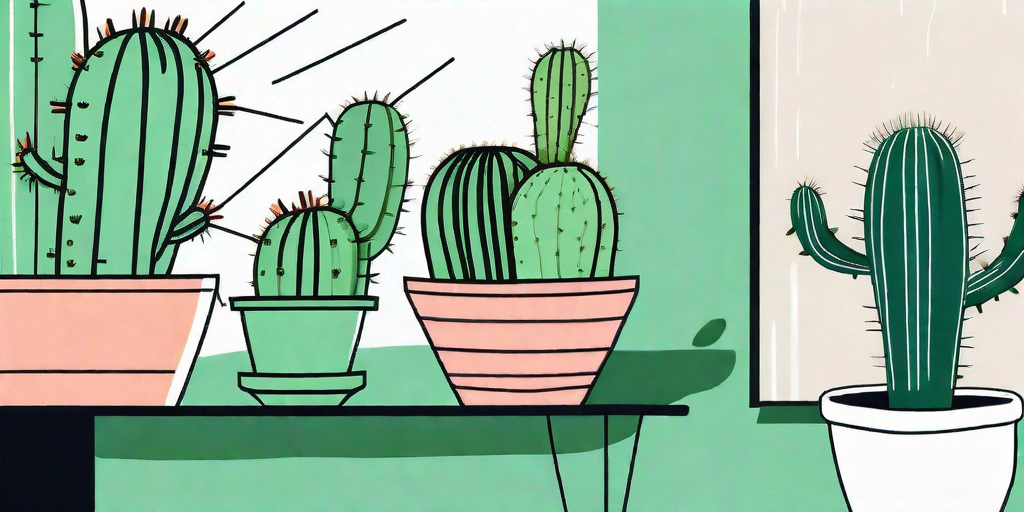
If you're a cactus lover, you know that these prickly pals are more than just a trendy piece of home decor. They're living, breathing organisms that require care and attention. And just like us, they can suffer from a variety of ailments, including the dreaded cactus scabbing. But fear not, dear cacti enthusiasts! We are here to arm you with the knowledge and tools to combat this pesky problem and restore your spiky friends to their former glory.
Understanding Cactus Scabbing
Before we dive into the solutions, let's take a moment to understand what cactus scabbing is. It's not a sign that your cactus has been fighting in the plant equivalent of a boxing ring. Rather, it's a common issue that can affect any cactus, regardless of its species or care routine.
Scabbing is essentially a form of plant injury. It can be caused by a variety of factors, including pests, disease, or physical damage. The scab is a protective response, much like the scabs that form on our own skin when we get a cut or scrape. But unlike our scabs, cactus scabs aren't a sign of healing. Instead, they're a sign that something is wrong and needs to be addressed.
The Causes of Cactus Scabbing
There are several potential culprits behind cactus scabbing. The first is pests. Certain insects, such as mealybugs or scale insects, can cause damage to the cactus's skin, leading to scabbing. Fungal or bacterial infections can also cause scabbing. These infections often occur when the cactus is overwatered or kept in conditions that are too humid.
Physical damage is another common cause of scabbing. This can occur if the cactus is knocked over, poked, or otherwise injured. Even something as simple as a change in temperature or light conditions can cause scabbing, as the cactus's skin can crack or blister in response to stress.
How to Treat Cactus Scabbing
Now that we've identified the potential causes of cactus scabbing, let's move on to the fun part: the treatment. The good news is that with a little TLC, your cactus can be restored to its smooth and healthy self. So roll up your sleeves, put on your gardening gloves, and let's get to work!
First and foremost, it's important to identify the cause of the scabbing. This will determine the best course of treatment. If pests are the issue, you'll need to remove them and treat the cactus with an appropriate pesticide. If a fungal or bacterial infection is to blame, you'll need to treat the cactus with a fungicide or bactericide. And if physical damage is the cause, you'll need to give the cactus time to heal and take steps to prevent further injury.
Step-by-Step Guide to Treating Cactus Scabbing
-
Identify the cause of the scabbing. Look for signs of pests, check the cactus's watering schedule and living conditions, and examine the cactus for signs of physical damage.
-
Remove any pests by hand or with a soft brush. Treat the cactus with an appropriate pesticide, following the manufacturer's instructions carefully.
-
If a fungal or bacterial infection is suspected, treat the cactus with a fungicide or bactericide. Again, follow the manufacturer's instructions to the letter.
-
If physical damage is the cause, give the cactus time to heal. Avoid moving the cactus or exposing it to extreme temperatures or light conditions.
-
Monitor the cactus closely for signs of improvement. If the scabbing doesn't improve or worsens, consider consulting a plant health professional.
Preventing Cactus Scabbing
As the old saying goes, prevention is better than cure. This is certainly true when it comes to cactus scabbing. By taking a few simple steps, you can help prevent this issue from occurring in the first place.
Firstly, ensure your cactus is in the right environment. Cacti prefer dry, warm conditions with plenty of light. Avoid overwatering your cactus, as this can lead to fungal or bacterial infections. Similarly, avoid exposing your cactus to extreme temperatures or sudden changes in light conditions, as this can cause stress and lead to scabbing.
Secondly, keep an eye out for pests. Regularly inspect your cactus for signs of insects and treat any infestations promptly. Finally, handle your cactus with care to avoid causing physical damage.
Top Tips for Preventing Cactus Scabbing
-
Keep your cactus in a dry, warm environment with plenty of light.
-
Avoid overwatering your cactus. Remember, cacti are desert plants and don't require a lot of water.
-
Inspect your cactus regularly for signs of pests and treat any infestations promptly.
-
Handle your cactus with care to avoid causing physical damage.
Frequently Asked Questions
Why is my cactus scabbing?
Scabbing can be caused by a variety of factors, including pests, disease, or physical damage. It's important to identify the cause of the scabbing in order to treat it effectively.
How can I prevent cactus scabbing?
Preventing cactus scabbing involves providing the right environment for your cactus, avoiding overwatering, regularly inspecting for pests, and handling your cactus with care.
What should I do if my cactus is scabbing?
If your cactus is scabbing, identify the cause of the scabbing and treat it accordingly. This may involve removing pests, treating a fungal or bacterial infection, or giving the cactus time to heal from physical damage.
In conclusion, cactus scabbing can be a cause for concern, but it's not a death sentence for your prickly pal. With the right knowledge and care, you can help your cactus recover and prevent future scabbing. So don't despair, cactus lovers! Your spiky friends are tougher than they look, and with a little help, they can bounce back from scabbing in no time.















